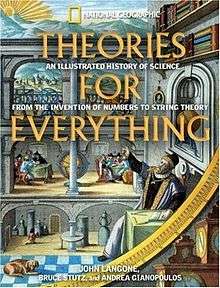Theories for Everything
This article is about the History of Science book. For other uses, see Theory of everything (disambiguation).
 | |
| Author | Bruce Stutz, John Langone and Andrea Gianopoulos |
|---|---|
| Country | United States |
| Language | English |
| Genre | Non-fiction |
| Publisher | National Geographic Society |
Publication date | 2006 |
| Media type | Print (Leather Cover and Hard Cover versions) |
| Pages | 408pp. (Deluxe version) |
| ISBN | 0-7922-3912-1 |
| OCLC | 70232302 |
| 509 22 | |
| LC Class | Q125 .L29 2006 |
Theories for Everything: An Illustrated History of Science, From the Invention of Numbers to String Theory is a book, published by the National Geographic Society in 2006.[1][2]
Overview
The book details the history of science from its earliest beginnings to the latest discoveries. Available in two versions, Deluxe and Standard, it was originally offered to National Geographic Society members and subsequently in the society's online shop. The book was co-authored by Bruce Stutz, Andrea Gianopoulos, and John Langone to whom it was dedicated. Theories for Everything is subdivided into six chapters, each focusing on a specific area of science and highlighting the achievements of scientists in that discipline.
Chapters
- Introduction - Bruce Stutz
- The Heavens - Andrea Gianopoulos
- The Human Body - John Langone
- Matter and Energy - Bruce Stutz
- Life Itself - Bruce Stutz
- Earth and Moon - Andrea Gianopoulos
- Mind and Behaviour - John Langone
References
- ↑ "Theories for Everything: An Illustrated History of Science". Goodreads. goodreads.com. Retrieved 13 May 2016.
- ↑ "Theories for everything : an illustrated history of science from the invention of numbers to string theory /". Buffalo & Erie County Public Library. buffalolib.org. Retrieved 13 May 2016.
External links
This article is issued from Wikipedia - version of the 5/13/2016. The text is available under the Creative Commons Attribution/Share Alike but additional terms may apply for the media files.